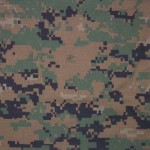In The Atlantic, D.B. Grady reminds us that some patterns are more deeply dyed than others:
Military combat uniforms have two purposes: to camouflage soldiers, and to hold together in rugged conditions. It stands to reason that there’s only one “best” pattern, and one best stitching and manufacture. It should follow that when such a uniform is developed, the entire military should transition to it.
 In 2002, the Marine Corps adopted a digital camouflage pattern called MARPAT. Rigorous field-testing proved that it was more effective than the splotched woodland pattern in use at the time, and the Combat Utility Uniform (of which it was a part) was a striking change for such a conservative institution.
In 2002, the Marine Corps adopted a digital camouflage pattern called MARPAT. Rigorous field-testing proved that it was more effective than the splotched woodland pattern in use at the time, and the Combat Utility Uniform (of which it was a part) was a striking change for such a conservative institution.
 Not to be outdone, the Army drew up digital plans of its own, and in 2005 issued a redesigned combat uniform in a “universal camouflage pattern” (UCP). Three years after the Marines made the change, four years after the invasion of Afghanistan, and two years after the invasion of Iraq, you might think the Army would have been loaded with data on how best to camouflage soldiers in known combat zones. You would be wrong.
Not to be outdone, the Army drew up digital plans of its own, and in 2005 issued a redesigned combat uniform in a “universal camouflage pattern” (UCP). Three years after the Marines made the change, four years after the invasion of Afghanistan, and two years after the invasion of Iraq, you might think the Army would have been loaded with data on how best to camouflage soldiers in known combat zones. You would be wrong.
In fact, not only did the Army dismiss the requirements of the operating environments, but it also literally chose the poorest performing pattern of its field tests. The “universal” in UCP refers to jungle, desert, and urban environments. In designing a uniform for wear in every environment, it designed a uniform that was effective in none.
[. . .]
Such dysfunction is not unique to the Army. MARPAT was a success not only in function, but also in adding distinction to the Marines wearing it. Naturally the Air Force wanted in on that action, and set about to make its own mark on the camouflage world. It’s first choice? A Vietnam-era blue tiger-stripe pattern. (You know, to blend in with the trees on Pandora.)
After an outcry in the ranks, the leadership settled on a color scheme slightly more subdued. The new uniform did, however, have the benefit of being “winter weight” only, which was just perfect for service in Iraq.





